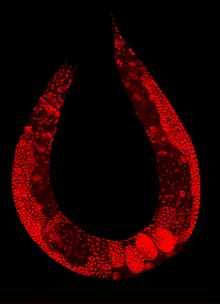
Back Vielzeller ALS متعددة الخلايا Arabic বহুকোষী জীৱ AS Многоклетъчно Bulgarian বহুকোষী জীব Bengali/Bangla Bevedeg lieskellig BR Organisme pluricel·lular Catalan Daghang-selyulang organismo CEB Mnohobuněčnost Czech Organeb amlgellog CY

A multicellular organism is an organism that consists of more than one cell, in contrast to unicellular organism.[1] All species of animals, land plants and most fungi are multicellular, as are many algae, whereas a few organisms are partially uni- and partially multicellular, like slime molds and social amoebae such as the genus Dictyostelium.[2][3]
Multicellular organisms arise in various ways, for example by cell division or by aggregation of many single cells.[4][3] Colonial organisms are the result of many identical individuals joining together to form a colony. However, it can often be hard to separate colonial protists from true multicellular organisms, because the two concepts are not distinct; colonial protists have been dubbed "pluricellular" rather than "multicellular".[5][6] There are also macroscopic organisms that are multinucleate though technically unicellular, such as the Xenophyophorea that can reach 20 cm.
- ^ Becker, Wayne M.; et al. (2008). The world of the cell. Pearson Benjamin Cummings. p. 480. ISBN 978-0-321-55418-5.
- ^ Chimileski, Scott; Kolter, Roberto (2017). Life at the Edge of Sight: A Photographic Exploration of the Microbial World. Harvard University Press. ISBN 9780674975910.
- ^ a b Lyons, Nicholas A.; Kolter, Roberto (April 2015). "On the evolution of bacterial multicellularity". Current Opinion in Microbiology. 24: 21–28. doi:10.1016/j.mib.2014.12.007. ISSN 1879-0364. PMC 4380822. PMID 25597443.
- ^ S. M. Miller (2010). "Volvox, Chlamydomonas, and the evolution of multicellularity". Nature Education. 3 (9): 65.
- ^ Brian Keith Hall; Benedikt Hallgrímsson; Monroe W. Strickberger (2008). Strickberger's evolution: the integration of genes, organisms and populations (4th ed.). Hall/Hallgrímsson. p. 149. ISBN 978-0-7637-0066-9.
- ^ Adl, Sina; et al. (October 2005). "The New Higher Level Classification of Eukaryotes with Emphasis on the Taxonomy of Protists". J. Eukaryot. Microbiol. 52 (5): 399–451. doi:10.1111/j.1550-7408.2005.00053.x. PMID 16248873. S2CID 8060916.